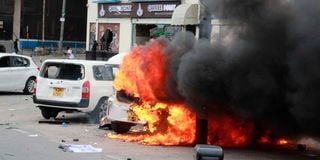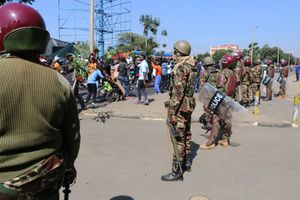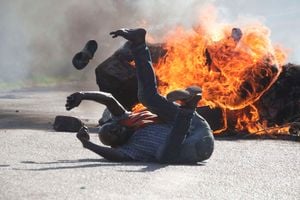
Some of the vehicles set ablaze on Nyerere Avenue in Mombasa during anti-government protests on July 2, 2024
Something scared Brenda Kangai on June 25, the day protesters stormed Parliament Buildings. She ended her participation in the protests and left for home at 1pm, much earlier than initially planned.
There was something terrifying about some of the faces in the protests. They looked fishy, weird, menacing. They were not the Gen Zs she had come to join in projecting their voices against the Finance Bill 2024. At 28, Brenda is just a year outside the Gen Zs’ age bracket.
What set off the alarm bells was the fact that some of her friends were robbed of their phones that morning. A movement that was characterised by smartphone-wielding young Kenyans taking to the streets and live-recording the unfolding scenes was turning into a dangerous affair, where phones could disappear in thin air.
“By 11am, there were so many people and most of them did not look like demonstrators. They looked like thugs,” Ms Kangai told Nation in an interview.
“I remember so many people I was with lost phones. That is what made me leave town. I had to hide my phone on one side of my trousers because I always wear long tops. I couldn’t hold it in my hand,” she added.
Brenda is one of three young Kenyans who poured their disappointment to Nation on Wednesday discussing how the previously marches were hijacked by goons.

Kenya Defence Forces lorry drives past a bonfire lit by anti-government protesters in Karatina town in Nyeri County on July 2, 2024.
The initial clarion call by the youthful demonstrators was for peace. No wielding stones as has been typical with earlier mass actions, just phones. The youths were to arrest anyone who broke the law and hand them to the police. They were not to resist arrest. They were not to block the police from doing their work.
However, as the twice-a-week protests gained momentum starting from June 18, these rules were trampled on the caking tarmacs of the city. Looting came into the picture. Muggings were reported. Windows were smashed. Bonfires were lit.
It was no longer a movement reserved for placard-wielding, whistle-blowing, sneaker-wearing and bandana-wrapped young faces. Businesses that were initially offering water and even food to protesters quickly took to slamming their doors shut and praying that the mobs wouldn’t swarm in and ruin their livelihoods.
Peaceful demonstration
Brenda has not taken part in the protests that followed the June 25 one.
“That was my last because we were demonstrating to make a change and all of a sudden, goons took over,” she said on July 3, 2024.
Having taken part in past protests in Nairobi, Brenda said she can always tell who is up to no good in a crowd.
“You will notice that they act weird. They want to push towards you and all that. They are also there at political rallies. Don’t some people go to rallies to steal? They are not interested in hearing what is being said,” said Brenda. “As an experienced demonstrator, I can tell a peaceful demonstration from thuggery.”
Azimio la Umoja leader Raila Odinga on Wednesday issued a statement echoing Brenda’s sentiments of the protests being hijacked.

Two vehicle burn along Nyerere Avenue in Mombasa after being set ablaze by anti-government protesters July 2, 2024.
“The scenes of people looting, vandalising and robbing were way different from what was witnessed at the start of the protests when the Gen Z were in complete control of the process and its programmes,” Mr Odinga said in a statement.
“People who were clearly not the Gen Z that started the initial protests hijacked it, looted businesses, attacked innocent Kenyans and destroyed critical infrastructure,” he added.
During a roundtable interview with media editors on Sunday, President William Ruto said businesses in the country had lost Sh2.4 billion to destruction linked to the protests.
Mr Moses Mabeya, a Nairobi-based lawyer, is another Kenyan who turned out to picket as the law allows him to.
“The demos have all along been peaceful. It was a spectacular sight — seeing young Kenyans from all walks of life united in advocating for rejection of the Finance Bill,” Mr Mabeya told Nation.
To his disappointment, he said, police acted brutally and killed “otherwise peaceful young men and women whose only crime was to advocate for better living conditions”.
His other source of displeasure is the fact that goons entered the scene.
Destruction of property
“When this (police brutality) did not break the people’s resolve, they (government) paid goons to cause mayhem and destruction of property. I personally saw the said goons walk side-by-side with the police. The police officers threw teargas and chased people from certain streets and when the streets were clear from any witnesses, the goons then descended on shops in full glare of the police officers,” claimed Mr Mabeya.
“We mourn our young brothers and sisters who were killed and promise that our resolve for a better Kenya does not just end with the disruption of our peaceful maandamanos. Also, it is a wake-up call to the ruling class that times have changed and we are no longer governed by fear,” added the lawyer.
Another young Kenyan who took to the streets with high hopes is Sumancha Laanoi, a global youth advocate. He was out in his full energy in the first three protests. He was out there on June 25 as the #OccupyParliament protest gained momentum.
“Everything was peaceful until we got closer to Parliament and some of the protesters were shot because some broke into Parliament and they started destroying (things). A fire was lit. That fire was not lit by the peaceful protesters. These were guys who were planted. These guys wanted to cause chaos so that it would be branded a violent demonstration,” said Mr Laanoi.
“You could get your friend losing their phone in that process, and you realised that it was no longer what we expected it to be. It was something else,” he lamented.
The July 2 protests in Nairobi broke his heart the most, as he saw unimagined levels of thuggery.
“Everything started with violence. These guys came from the Nairobi suburbs. I was in town very early in the morning, and I saw a group from Kariokor. They were assembling at Kariokor and wanted to get into town. They were repulsed by police. After a while, there was another group from Mathare that found them there at the same point. Now these guys were unstoppable. They entered the CBD. While they were walking around town, they were not demonstrating peacefully. They would break into any shop that looked easy to rip open. Then they would get in and steal. They would even rob protesters of their phones,” he said.
He said some of the people he believed were goons appeared unkempt and were foul-mouthed in the way they expressed themselves.
Vulgar language
“They were using vulgar language. They were abusive and were throwing stones. And they were destroying things in town. They were even destroying the pathways,” said Mr Laanoi.
The gushing passions of the Gen Z had, in effect, been muddied by the damage-minded persons. Placards and flags in their enraged hands gave way to others carrying metal rods and other crude weapons. The call was reversed to “no phones, just stones”. The public sentiment changed from “brave Gen Zs” to “hao ni wakora”. The Finance Bill, which caused the protests in the first place, fell, but with it also fell the good intentions of Kenya’s youth.
“I’m a peaceful person. I had gone to the protests just with a bottle of water, my whistle, my Kenyan flag, and nothing more. I was expecting to meet like-minded protesters but I met thugs instead,” remarked Brenda. “I have never seen what I saw on Tuesday (June 25). That is why I sensed danger. There were people who were sent to do evil things.”
Brenda challenged the government to collect all CCTV footage in places that were looted and identify the people behind them.
“The government cannot do this because most of them (looters) have been paid by that government. Most of them are not real demonstrators,” she claimed, without offering evidence.
The police have said they are gathering evidence against six politicians, two NGOs and a businessman for their involvement in mobilising and financing violent demonstrators.
In Rongai, a trader who lost all his shop’s stock on June 27 also wondered whether these were the usual protesters who turned up at the beginning of the mass demonstrations, as they were armed with weapons.
“Even with elections, it has not been this bad. Demos have been happening at the road, but many people have never reached here. I don’t know if (these) were Gen Z protests or these were infiltrated by thugs,” he said last week.
Incidents of looting, robbing and damage to property were also witnessed in Mombasa, Nakuru, Nyeri, Kisii, among other areas.
Mr Odinga said the turning of the protests into mayhem “amounts to a double betrayal of the youth”.
“The bad manners have to be stopped,” stated Mr Odinga.







